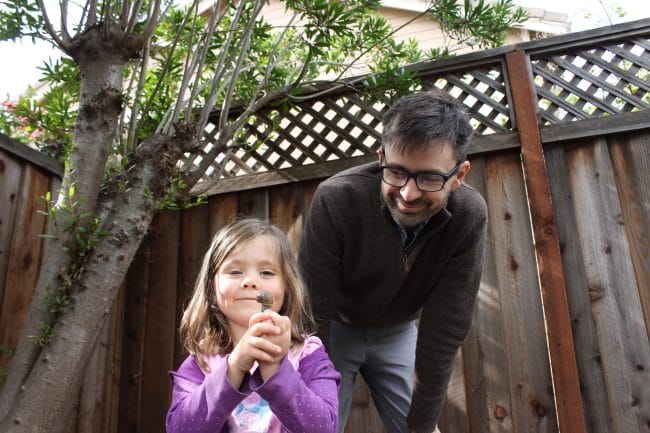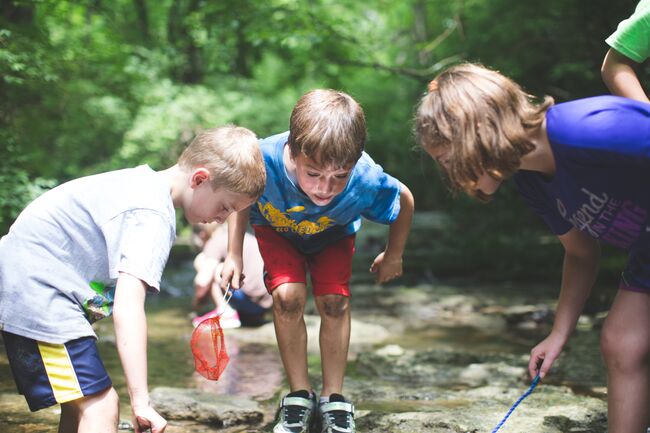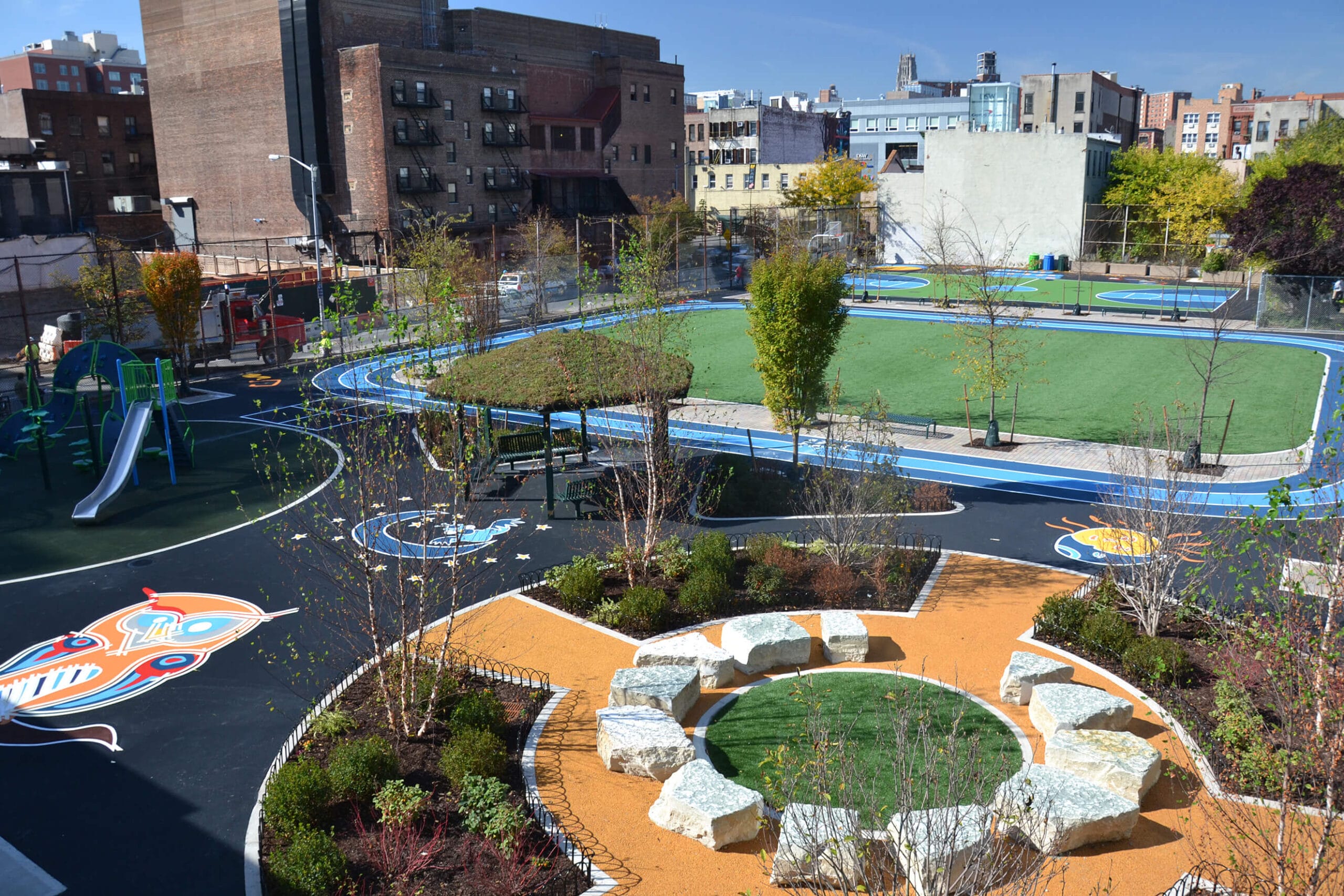
A walk on the wild sidewalk: on safari with a city naturalist
A walk on the wild sidewalk: on safari with a city naturalist
Pigeons are noble. Crows are good judges of character. Snails are underrated. Weeds are … delicious?
These aren’t commonly held opinions—even among those of us who look to the beauty and diversity of the outdoors for inspiration. But to writer and naturalist Nathanael Johnson, familiar plants and animals are no less impressive or worthy of study than those found in remote wilderness. With his daughters, aged 6 and 3, he’s on a mission to explore and share the surprising, thriving, and often weird world of our non-human neighbors.
 With his daughters, aged 6 and 3, author Nathanael Johnson is on a mission to explore and share the surprising, thriving, and often weird world of our non-human neighbors.Photo credit: Sandra Reboucas
With his daughters, aged 6 and 3, author Nathanael Johnson is on a mission to explore and share the surprising, thriving, and often weird world of our non-human neighbors.Photo credit: Sandra Reboucas
Johnson’s latest book, Unseen City, chronicles his family’s transformation from distracted, indifferent city-dwellers to avid urban naturalists. It’s a rewarding journey, he says, but not without its challenges: he agreed to take us out on safari—a stroll around his neighborhood in Berkeley, California—and share his top tips for exploring nature close to home.
1. Think like a kid (or bring one along)
“Daddy, what’s this?” For parents of toddlers, the familiar refrain can get a little tiresome—but Johnson says it was his younger daughter’s constant questioning that first brought their neighborhood’s natural world into focus. “I was walking Josephine home from daycare, and she was pointing at every tree we passed, asking, ‘That?’ and, ‘That?’ and, ‘That?’” Johnson says. “I got bored of just saying, ‘Tree,’ ‘Also a tree,’ ‘Still just a tree,’ so I started to get more specific: ‘Trunk,’ or ‘Leaves,’ or ‘Branches.’”
As he changed the way he answered his daughter’s questions, Johnson began to notice things he’d never seen before—like the delicate yellow blooms on a tree that he passed by every day. “I was always into nature as a kid, but I didn’t realize how clouded my vision had become. When did I stop paying attention? Then Josephine came along and started literally pointing out everything I’d been ignoring. It was genuinely shocking—and also kind of magical.”
 Kids are curiosity machines, which Johnson admires and emulates. “I was always into nature as a kid, but I didn’t realize how clouded my vision had become,” he says. “When did I stop paying attention?”Photo credit: Kelly Fortener
Kids are curiosity machines, which Johnson admires and emulates. “I was always into nature as a kid, but I didn’t realize how clouded my vision had become,” he says. “When did I stop paying attention?”Photo credit: Kelly Fortener
2. Find the exotic in the everyday
Urban naturalists argue that the ability to thrive alongside humans doesn’t make a squirrel or raccoon any less wild than a lion or a tiger. For Johnson, the fun of a city safari is getting to know familiar creatures’ wild sides: over the past few years, Johnson has discovered that your run-of-the-mill pigeon sports an otherworldly, bright-red eye; that the ants overrunning your picnic are engaged in an elaborate turf war; and that crows stage funerals for their dead. “I want people to challenge their ideas of nature as this romantic, remote force,” says Johnson. “Sparking natural wonder without leaving civilization is a more pragmatic and useful approach for our future on the planet.”
3. Use human resources
Johnson pauses on our walk to point out a Chinese fringe flower, a deep red shrub that’s popular among gardeners—but rarely listed in field guides because it doesn’t occur naturally in Northern California. So how did he learn to identify it? “I have a friend who works in landscaping—landscapers know all the ornamental species like this,” Johnson says. “I start to forget information from guide books almost immediately—I learn better from knowledgeable people who can answer my questions.”
Most of us don’t have a crew of expert naturalists on speed dial, so Johnson recommends linking up with a local birding club or hiking group to meet people with similar interests. But sometimes they’ll come to you: Johnson says he’s picked up tips from passersby and neighbors—fellow city naturalists—who notice him looking closely at a plant or insect.
 “I want people to challenge their ideas of nature as this romantic, remote force,” says Johnson. “Sparking natural wonder without leaving civilization is a more pragmatic and useful approach for our future on the planet.”Photo credit: Hannah Lozano
“I want people to challenge their ideas of nature as this romantic, remote force,” says Johnson. “Sparking natural wonder without leaving civilization is a more pragmatic and useful approach for our future on the planet.”Photo credit: Hannah Lozano
4. Have patience, young grasshopper
You and your family might not become experts overnight, says Johnson, but that’s okay—you’re learning a whole new way of looking at the world. “We’re accustomed to things like smartphones that are way more superficially engaging—sometimes my brain goes through a little freak-out when I go outside for observations, like, ‘No! Don’t leave me to my own devices!’” He compares the act of paying close attention to nature to flexing a muscle: the more you work it, the stronger you get. The rewards, he says, are worth the work: a satisfying sense of place, a more honest understanding of the world we share, and a pastime that gets you and your family outside.
“It’s a different form of thinking than a lot of us are used to, but cultivating attention to the environment helps me elsewhere in life—it generates new ideas and ignites creativity.” says Johnson. “It’s gratifying to look at something long enough to burn through your prior assumptions—and see what’s actually there.”
This raw, beautiful landscape in Southern California is home to Indigenous heritage sites, and it provides critical habitat for threatened and endangered species. Urge President Biden to safeguard this extraordinary landscape today!


Donate to become a member, and you’ll receive a subscription to Land&People magazine, our biannual publication featuring exclusive, inspiring stories about our work connecting everyone to the outdoors.
See how our supporters are helping us connect people to the outdoors across the country.











